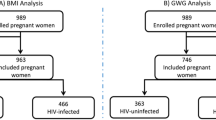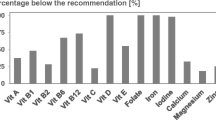Abstract
Objectives
To describe the dietary patterns in pregnant woman and determine the association between diet factors, pre-pregnancy Body Mass Index (BMI) and socio-demographic characteristics with gestational weight gain (GWG).
Methods
This is a secondary analysis of a longitudinal cohort study of pregnant women exploring the risk factors for preterm birth, the Puerto Rico Testsite for Exploring Contamination Threats program. Recruitment was conducted during 2011–2014. Data was collected from multiple sources. GWG was calculated using maternal weight recorded in the medical records at the first and last prenatal visits and classified according to the Institute of Medicine guidelines. Sociodemographic characteristics were obtained at baseline using an interviewed-based questionnaire. Participants completed a self-administered food frequency questionnaire at 20–28 weeks to assess dietary patterns. Analysis of associations between variables was conducted using Chi Square tests.
Results
A total of 160 women with term pregnancies were included in this analysis. Mean pre-pregnancy BMI was 25.4 ± 5.48 kg/m2, with 44.4 % classified as overweight/obese. Excessive GWG was observed in 24.4 % of the participants. Socio-demographic characteristics were not associated with GWG. Being overweight/obese at the start of pregnancy was significantly associated with excessive GWG (p < 0.05). In addition, women consuming one or more fruit drinks per day were more likely to have an excessive GWG while those consuming less than one fruit drink per day were more likely to have an adequate GWG (p < 0.05).
Conclusions for Practice
Being obese before pregnancy and frequently consuming fruit drinks were important determinants of excessive GWG in this group.

Similar content being viewed by others
References
Kaiser, L., & Allen, L. H. (2008). American Dietetic Association. Position of the American Dietetic Association: Nutrition and lifestyle for a healthy pregnancy outcome. Journal of the American Dietetic Association, 108(3), 553–561.
Williamson, C. (2006). Nutrition in pregnancy. Nutrition Bulletin, 31, 28–59.
Melere, C., Hoffmann, J. F., Nunes, M. A., Drehmer, M., Buss, C., Ozcariz, S. G., et al. (2013). Healthy eating index for pregnancy: Adaptation for use in pregnant women in Brazil. Revista de Saude Publica, 47(1), 20–28.
Reyes, N. R., Klotz, A. A., & Herring, S. J. (2013). A qualitative study of motivators and barriers to healthy eating in pregnancy for low-income, overweight, African-American mothers. Journal of the Academy of Nutrition and Dietetics, 113(9), 1175–1181. doi:10.1016/j.jand.2013.05.014.
Guelinckx, I., Devlieger, R., Beckers, K., & Vansant, G. (2008). Maternal obesity: Pregnancy complications, gestational weight gain and nutrition. Obesity Reviews, 9(2), 140–150. doi:10.1111/j.1467-789X.2007.00464.x.
Leddy, M. A., Power, M. L., & Schulkin, J. (2008). The impact of maternal obesity on maternal and fetal health. Reviews in Obstetrics and Gynecology, 1(4), 170–178.
World Health Organization (2000). Obesity: Preventing and managing the global epidemic. Geneva: World Health Organization.
Chasan-Taber, L. (2012). Physical activity and dietary behaviors associated with weight gain and impaired glucose tolerance among pregnant Latinas. Advances in Nutrition, 3(1), 108–118. doi:10.3945/an.111.001214.
American Dietetic Association, American Society of Nutrition, Siega-Riz, A. M., & King, J. C. (2009). Position of the American Dietetic Association and American Society for Nutrition: Obesity, reproduction, and pregnancy outcomes. Journal of the American Dietetic Association, 109(5), 918–927.
Rodrigues, P. L., de Oliveira, L. C., Brito Ados, S., & Kac, G. (2010). Determinant factors of insufficient and excessive gestational weight gain and maternal-child adverse outcomes. Nutrition, 26(6), 617–623. doi:10.1016/j.nut.2009.06.025.
Chu, S. Y., Callaghan, W. M., Bish, C. L., & D’Angelo, D. (2009). Gestational weight gain by body mass index among US women delivering live births, 2004–2005: Fueling future obesity. American Journal of Obstetrics and Gynecology, 200(3), 271.e1–271.e7. doi:10.1016/j.ajog.2008.09.879.
Olafsdottir, A. S., Skuladottir, G. V., Thorsdottir, I., Hauksson, A., & Steingrimsdottir, L. (2006). Maternal diet in early and late pregnancy in relation to weight gain. International Journal of Obesity, 30(3), 492–499.
Institute of Medicine. (2009). Weight gain during pregnancy: Reexamining the guidelines. Washington D.C.: National Academies Press; pp. 1–4. http://iom.edu/~/media/Files/Report%20Files/2009/Weight-Gain-During-Pregnancy-Reexamining-the-Guidelines/Report%20Brief%20-%20Weight%20Gain%20During%20Pregnancy.pdf.
Carroll, M. D., Kit, B. K., Lacher, D. A., & Yoon, S. S. (2013). Total and high-density lipoprotein cholesterol in adults: National health and nutrition examination survey, 2011–2012. NCHS Data Brief, 132, 1–8.
Dalenius, K., Brindley, P., Smith, B., Reinold, C., & Grummer-Strawn, L. (2012). Pregnancy nutrition surveillance 2010 report. Atlanta: U.S. Department of Health and Human Services, Centers for Disease Control and Prevention.
Stuebe, A. M., Oken, E., & Gillman, M. W. (2009). Associations of diet and physical activity during pregnancy with risk for excessive gestational weight gain. American Journal of Obstetrics and Gynecology, 201(1), 58.e1–58.e8. doi:10.1016/j.ajog.2009.02.025.
Sayon-Orea, C., Bes-Rastrollo, M., Basterra-Gortari, F. J., Beunza, J. J., Guallar-Castillon, P., de la Fuente-Arrillaga C., et al. (2013). Consumption of fried foods and weight gain in a mediterranean cohort: The SUN project. Nutrition, Metabolism and Cardiovascular Diseases, 23(2), 144–150. doi:10.1016/j.numecd.2011.03.014.
Meeker, J. D., Cantonwine, D. E., Rivera-Gonzalez, L. O., Ferguson, K. K., Mukherjee, B., Calafat, A. M., et al. (2013). Distribution, variability, and predictors of urinary concentrations of phenols and parabens among pregnant women in Puerto Rico. Environmental Science and Technology, 47(7), 3439–3447.
United States Census Bureau. (2012). Poverty thresholds for 2012 by size of family and number of related children under 18 years. https://www.census.gov/hhes/www/poverty/data/threshld/. Updated 2012.
Centers for Disease Control and Prevention. U.S. Department of Health and Human Services (2011). http://www.cdc.gov/nchs/nhis/quest_data_related_1997_forward.htm.
Centers for Disease Control and Prevention. U.S. Department of Health and Human Services (2009–2010). National Health and Nutrition Examination Survey (NHANES). http://www.cdc.gov/nchs/nhanes/nhanes2009-2010/questionnaires09_10.htm.
Centers for Disease Control and Prevention. U.S. Department of Health and Human Services Public Health Service (2010). Birth defects prevention study. http://www.reginfo.gov/public/do/DownloadDocument?documentID=320061&version=1.
Chin, J. R., Krause, K. M., Ostbye, T., Chowdhury, N., Lovelady, C. A., & Swamy, G. K. (2010). Gestational weight gain in consecutive pregnancies. American Journal of Obstetrics and Gynecology, 203(3), 279.e1–279.e6. doi:10.1016/j.ajog.2010.06.038.
Tucker, K. L., Bianchi, L. A., Maras, J., & Bermudez, O. I. (1998). Adaptation of a food frequency questionnaire to assess diets of Puerto Rican and non-Hispanic adults. American Journal of Epidemiology, 148(5), 507–518.
Palacios, C., Trak, M., Betancourt, J., Joshipura, K., & Tucker, K. (2015). Validation and reproducibility of a semi-quantitative food frequency questionnaire as a measure of dietary intake in adults from Puerto Rico. Cambridge Journals,. doi:10.1017/S1368980014003218.
Willett, W. C. (2013). Nutritional epidemiology (3rd ed.). New York: Oxford University Press.
Butte, N. F., Ellis, K. J., Wong, W. W., Hopkinson, J. M., & Smith, E. O. (2003). Composition of gestational weight gain impacts maternal fat retention and infant birth weight. American Journal of Obstetrics and Gynecology, 189(5), 1423–1432.
Wells, C., Schwalberg, R., Noonan, G., & Gabor, V. (2006). Factors influencing inadequate and excessive weight gain in pregnancy: Colorado, 2000–2002. Maternal and Child Health Journal, 10(1), 55–62.
Olson, C. M., Strawderman, M. S., & Reed, R. G. (2004). Efficacy of an intervention to prevent excessive gestational weight gain. American Journal of Obstetrics and Gynecology, 191(2), 530–536. doi:10.1016/j.ajog.2004.01.027.
Rosenberg, T. J., Garbers, S., Lipkind, H., & Chiasson, M. A. (2005). Maternal obesity and diabetes as risk factors for adverse pregnancy outcomes: Differences among 4 racial/ethnic groups. American Journal of Public Health, 95(9), 1545–1551.
Centers for Disease Control and Prevention. U.S. Department of Health and Human Services (2014). Preconception health and health care. http://www.cdc.gov/preconception/index.html.
Peterson, A., Johnson, B., Moulton, B. E., Smith, E. O., Suchman, A., Wilson, C., et al. (2010). Implementing SNAP in Puerto Rico: A feasibility study. Prepared by Insight Policy Research under Contract No. AG-3198-C-09-0001. Alexandria, VA: United States Department of Agriculture, Food and Nutrition Service. http://www.fns.usda.gov/sites/default/files/PuertoRico.pdf.
Instituto de Estadísticas de Puerto Rico (2009). Tendencias en la salud: Puerto Rico behavioral risk factor surveillance system (BRFSS). Actividad física. http://www.estadisticas.gobierno.pr/iepr/Publicaciones/Proyectosespeciales/TendenciasenlaSaludPRBRFSS/PRBRFSS/tabid/198/pid/2113/qid/6463/Default.aspx.
Acknowledgments
This project is supported by award P42ES017198-01A1 (Superfund Research for the National Institute of Environmental Health Sciences) and in part by awards G12RR03051 (RCMI Clinical Research Center), 5G12-MD007600 (Center for Collaborative Research in Health Disparities), and U54MD007587 (Puerto Rico Clinical and Translational Research Consortium) from the Institute on Minority Health and Health Disparities, National Institutes of Health. We gratefully acknowledge PROTECT research staff and collaborators: study nurses (Abigail Figueroa and Janisse Cabrera); trainees (Esteban Romero, Carlos Vergara, Claudia Pérez, Carolina Pérez, Suely Román, Krizia Santos, Andrea González and Brenda Castro) and the medical faculty, nursing, laboratory and administrative staff of the affiliated prenatal health clinics.
Conflict of interest
The authors have no conflict of interest to disclose.
Author information
Authors and Affiliations
Corresponding author
Rights and permissions
About this article
Cite this article
Guilloty, N.I., Soto, R., Anzalota, L. et al. Diet, Pre-pregnancy BMI, and Gestational Weight Gain in Puerto Rican Women. Matern Child Health J 19, 2453–2461 (2015). https://doi.org/10.1007/s10995-015-1764-4
Published:
Issue Date:
DOI: https://doi.org/10.1007/s10995-015-1764-4




